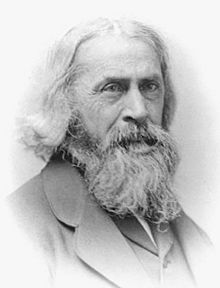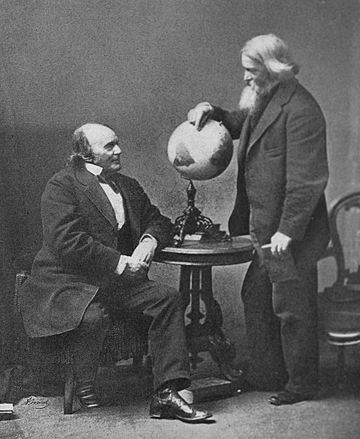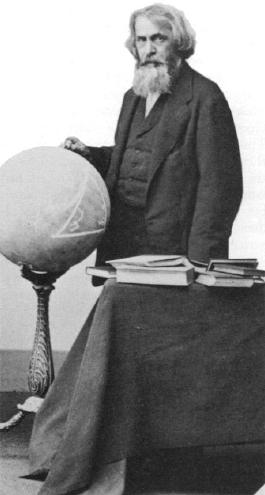Benjamin Peirce facts for kids
Quick facts for kids
Benjamin Peirce
|
|
|---|---|

Benjamin Peirce
|
|
| Born | April 4, 1809 |
| Died | October 6, 1880 (aged 71) Cambridge, Massachusetts
|
| Nationality | American |
| Alma mater | Harvard University |
| Known for | Peirce's criterion for outliers (statistics) Definition of mathematics as the science of necessary truths linear algebras celestial mechanics |
| Spouse(s) | Sarah Hunt Mills |
| Children | 5, including Charles and Herbert |
| Scientific career | |
| Fields | Mathematics Statistics Science policy |
| Institutions | Harvard University Superintendent of the United States Coast Survey |
| Academic advisors | Nathaniel Bowditch |
| Notable students | Joseph Lovering |
| Influenced | Charles Sanders Peirce |
| Relatives | Benjamin Peirce (father) |
| Signature | |
Benjamin Peirce (April 4, 1809 – October 6, 1880) was a very important American mathematician. He taught at Harvard University for about 50 years. He made big contributions to many areas of math and science. These included how planets move (called celestial mechanics), statistics, number theory, and algebra. He also thought deeply about the philosophy of mathematics, which is about what math truly is.
Contents
Early Life and Career
Benjamin Peirce was born in Salem, Massachusetts. His father, also named Benjamin Peirce, later became the librarian at Harvard.
After finishing his studies at Harvard University in 1829, Benjamin Peirce taught math for two years. In 1831, he became a math professor at Harvard. Later, in 1842, he also started teaching astronomy. He stayed a professor at Harvard until he passed away. He helped improve Harvard's science programs and even served as the college librarian. From 1867 to 1874, he was in charge of the U.S. Coast Survey. This group made maps of the American coast.
Because of his important work, he was chosen to be a member of the American Philosophical Society in 1842. In 1852, he became a Foreign Member of the Royal Society of London. This is a very respected scientific group.
Important Discoveries and Ideas
Benjamin Peirce is often seen as one of the first American scientists whose work was recognized as world-class. This means his ideas were important around the globe.
Mathematics and Logic
In number theory, which studies numbers and their properties, Peirce proved an interesting fact about certain numbers. He showed that there is no odd perfect number (a number that is the sum of its own divisors, like 6 = 1+2+3) that has fewer than four prime factors.
In algebra, which uses symbols to solve problems, he studied special types of algebras. He created terms like idempotent and nilpotent in 1870. These words describe certain elements within these math systems. He also introduced something called the Peirce decomposition.
Peirce had a famous idea about what mathematics is. He said, "Mathematics is the science that draws necessary conclusions." This means math helps us find truths that must be true if certain things are given. His son, Charles Sanders Peirce, who was also a famous thinker, said this idea helped start the philosophy of pragmatism. Like another mathematician named George Boole, Benjamin Peirce believed that math could be used to study logic. Logic is the study of correct reasoning. His son Charles further developed these ideas, even looking at faulty reasoning.
Statistics and Outliers
In statistics, which deals with collecting and analyzing data, Peirce came up with a way to handle outliers. Outliers are data points that seem very different from the rest of the data. His method is known as Peirce's criterion. His son Charles also helped develop these ideas.
Benjamin Peirce was once an expert witness in a court case called the Howland will forgery trial. He was helped by his son Charles. They looked at a questioned signature and found it was so similar to another handwriting example that it was almost impossible for it to be a coincidence. This showed how powerful math and statistics could be in real-world problems.
Personal Life

Benjamin Peirce was a very religious person. He believed that God shaped nature in ways that allowed pure mathematics to describe the world around us. He saw math as a way to study God's work.
He was also a fun person! He loved juggling with a toy called a diabolo. He even wrote about the physics of how the diabolo works in his book Analytic Mechanics.
Peirce married Sarah Hunt Mills. They had five children:
- James Mills Peirce (1834–1906), who also became a math professor at Harvard.
- Charles Sanders Peirce (1839–1914), who became a very famous logician and philosopher.
- Benjamin Mills Peirce (1844–1870), who worked as a mining engineer.
- Helen Huntington Peirce Ellis (1845–1923).
- Herbert Henry Davis Peirce (1849–1916), who worked in the Foreign Service.
Things Named After Him
- A lunar crater (a big bowl-shaped hole on the Moon) is named Peirce after him.
- An asteroid (a small rocky body in space) is named 29463 Benjaminpeirce.
- At Harvard University, special research positions for mathematicians are called Benjamin Peirce Fellows and Lecturers.
- A ship used by the United States Coast Survey was named USCS Benjamin Peirce in his honor. It was used from 1855 to 1868.
Works
- An Elementary Treatise on Plane and Spherical Trigonometry, 1840. This was a textbook about trigonometry.
- Physical and Celestial Mechanics, 1855. This book was about how objects move, especially in space.
- Linear Associative Algebra, 1872. This was a very important work on a type of algebra.
- A System of Analytical Mechanics, 1872. This book explained how to use math to study motion and forces.
See also
 In Spanish: Benjamin Peirce para niños
In Spanish: Benjamin Peirce para niños


